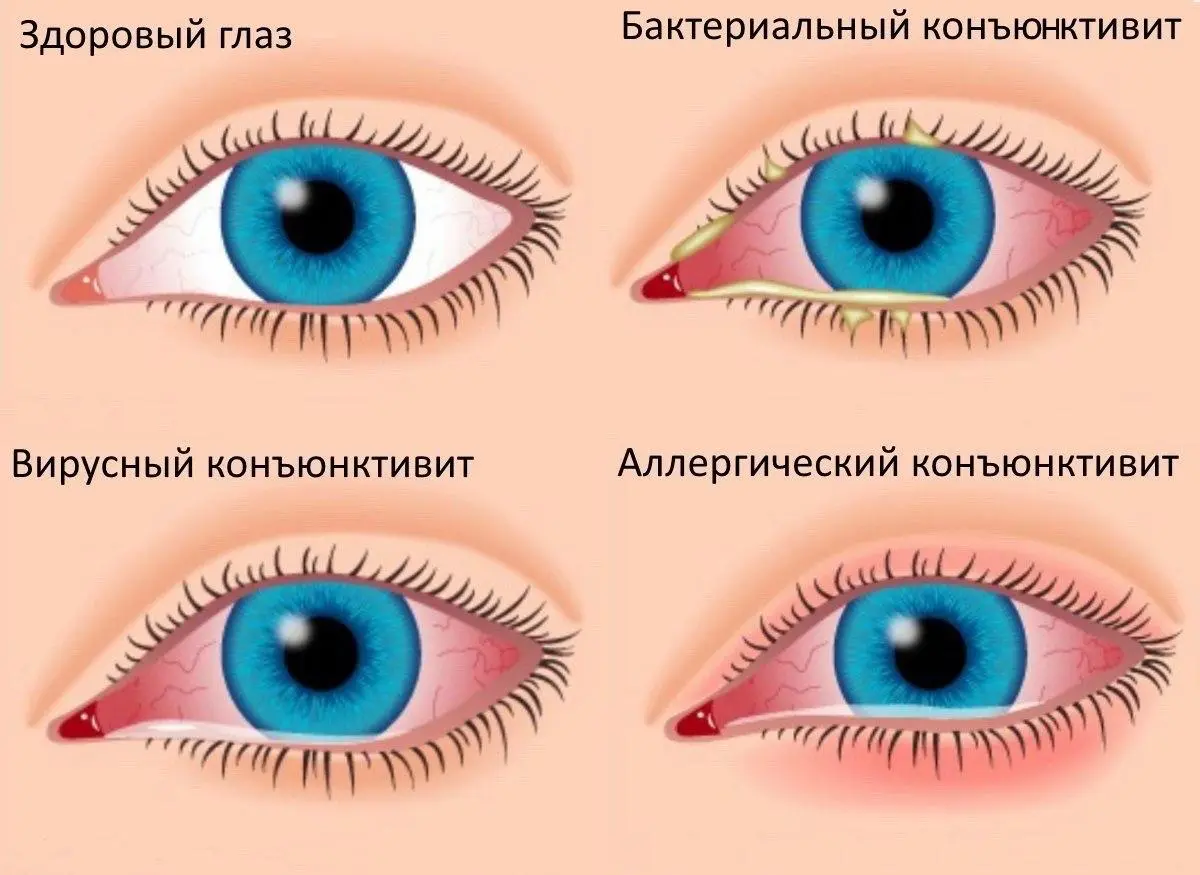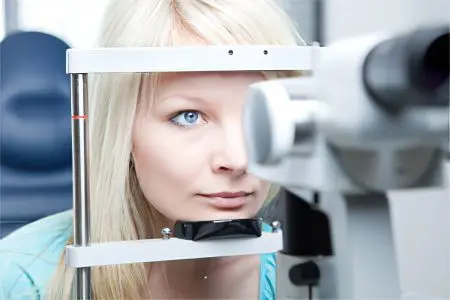Contents
Adenovirus conjunctivitis – This is an infectious lesion of the conjunctiva of the organs of vision. A person’s body temperature rises, rhinitis develops, and sore throats occur.
It is caused by adenoviruses of various types and manifests itself in the form of damage to the eyes. It is accompanied by severe lacrimation, redness of the eyes, swelling of the eyes and eyelids, pain, burning and sensation of a foreign body in the eye. The infection can be transmitted by airborne droplets or get on the mucous membrane of the organs of vision by contact with the eyes of dirty hands on which the virus is located.
Most often, children suffer from adenoviral conjunctivitis. This is due to the insufficient formation of hygiene skills. The infection enters the organs of vision along with dirty hands. If treatment is delayed, this can lead to serious complications. Therapy must be comprehensive. It comes down to the use of antiviral and antibacterial drugs.

Causes of adenovirus conjunctivitis

Adenovirus conjunctivitis is a highly contagious disease. Often due to this viral infection, massive epidemic outbreaks are observed. The disease is spreading especially actively in children’s organized groups. Acute periods are observed in autumn and spring.
In adults, adenoviral conjunctivitis manifests itself due to the ingestion of the pathogen. Each virus particle has its own DNA. This is its hallmark. The diameter of adenoviruses does not exceed 90 nm. The shape of the virus is represented by a sphere.
Adenoviruses show sufficient stability in the external environment. However, at a temperature of +50 °C, the viruses die. Products containing phenol and chloramine can destroy their structure.
Once in the tissues of a living organism, viruses begin to multiply actively. They damage the cells of their carrier, provoking the disintegration of their chromatin and the destruction of the nucleoli. To date, more than 40 serotypes of viruses are known. However, conjunctivitis is most often caused by strains numbered 4, 6, 7, 10. Subspecies of viruses 3, 7a, and 11 lead to massive outbreaks of the disease.
The infection is transmitted by airborne droplets. A contact mechanism for the spread of the virus is also being implemented. The disease is transmitted from one person to another during a conversation, sneezing, coughing. Children become infected through dirty hands, when touching the face and eyes.
Separately, it is necessary to highlight the risk factors that contribute to the development of the disease:
Subcooling the body.
Errors in hygiene.
Poor care for lenses and glasses.
Eyeball injury.
Surgical manipulations on the organs of vision.
Adenovirus conjunctivitis can occur in a membranous form, in a catarrhal and follicular type. In children, the membranous variety of conjunctivitis is most often diagnosed.
Immunity after a disease develops only to a specific virus serotype.
Symptoms of adenovirus conjunctivitis

From the period of time when the infection happened and until the moment of the first manifestations of the disease, about 5-7 days pass. However, sometimes this period is reduced to 3 days. Adults tolerate adenoviral conjunctivitis more easily than children. At the same time, the symptoms of the disease do not differ between them.
The onset of the disease always resembles a cold. A person’s body temperature rises, sore throats bother him, his nose is blocked, and a runny nose develops. The patient complains of a headache, the stool may become liquid.
Lymph nodes increase in size, respond with pain. After 2-3 days, the first symptoms of conjunctivitis appear. First, 1 eye becomes inflamed, but the infection quickly spreads to the second organ of vision. Eyelids swell, become red. The discharge can be both serous and purulent. Lachrymation intensifies, in bright light the eyes respond with pain. There is a feeling that a foreign body has fallen into them. Eyes itch, itch, whites may turn yellow.
Adenovirus conjunctivitis can occur in 3 forms.
Each of them is characterized by certain symptoms:
Filmy conjunctivitis. This form of the disease is typical for childhood. In the eyes, thin films are formed that cover the mucous membrane of the organ of vision. Such films can be easily removed with a cotton swab. They are grayish in color, transparent and not durable. If the films thicken, this may indicate that fibrin accumulates in them. They stick together with the conjunctiva and it is very difficult to remove them. When you try to do this, the mucous membranes are injured. This course of the disease is associated with the risk of scar tissue formation. However, this happens infrequently. Mostly damage to the mucous membrane of the eye is limited to small hemorrhages. Over time, they go away on their own. The membranous form of adenoviral conjunctivitis is accompanied by an increase in body temperature, intoxication of the body increases, which can last for a long time.
Catarrhal form of adenoviral conjunctivitis. With this type of infectious process, the conjunctiva of the eye turns red, but the secret is secreted in small quantities. The disease lasts no longer than a week, rarely combined with any complications.
Follicular form of conjunctivitis. Multiple vesicles appear on the mucous membranes of the eye, they will be filled with a clear liquid. Rashes appear on the eyelids, on the transitional fold. The mucous membrane of the organs of vision is loosened.
The disease can be complicated by the addition of bacterial flora, dry eye syndrome, keratitis, otitis and tonsillitis. However, they are not registered frequently. Complications are associated with the fact that the treatment of adenovirus infection was started late.
The average duration of illness is 2 weeks. If the treatment was of high quality and complete, then recovery can come faster.

The acute form of the disease is diagnosed by an ophthalmologist. The doctor makes a diagnosis based on the examination of the patient. It visualizes the main manifestations of infection: swelling of the eyelids, redness of the mucous membranes, discharge from the eyes. The patient will have enlarged lymph nodes in the neck.
To confirm the diagnosis, the doctor may prescribe the following laboratory tests:
ELISA (enzymatic immunoassay). This study allows you to detect the titer of antibodies in the blood that are produced for a specific infectious agent. With adenoviral conjunctivitis, these values increase 4 times. However, this technique cannot be classified as urgent. With adenovirus infection, blood sampling will need to be carried out 2 times: at an early stage of the development of the disease and after its completion.
REEF. This method allows you to quickly identify the causative agent of the disease. For analysis, a smear is taken from the conjunctiva.
PCR. The technique is aimed at detecting the DNA molecule of a pathogenic organism. It is isolated from a smear taken from the conjunctiva. To conduct the analysis, doctors will need sophisticated equipment. The method is expensive, therefore, with adenoviral conjunctivitis, it is rarely resorted to.
Bacterial examination of discharge from the conjunctiva. It makes it possible to determine the bacterial flora that may accompany adenovirus infection. It will take about a week to get the result.
Symptoms of adenoviral conjunctivitis resemble those of bacterial inflammation. The treatment of these two pathologies is different, so it is important to accurately diagnose. With improperly selected therapy, the likelihood of developing severe complications, up to loss of vision, increases. It is impossible to try to determine the disease on your own and begin to treat it. When the first signs of inflammation appear, you need to consult a specialist.
It is important to conduct a differential diagnosis of adenoviral conjunctivitis with glaucoma, iritis, keratitis, episcleritis. Also, conjunctivitis can be fungal, herpetic, bacterial, chlamydial. At the same time, the clinical course of the listed inflammatory reactions often resembles adenoviral conjunctivitis.
Treatment of adenovirus conjunctivitis

The treatment of adenoviral conjunctivitis will require the implementation of an integrated approach. The patient is prescribed local and systemic therapy, and the age of the patient does not matter. In addition to antiviral drugs, antibiotics can be used. They are used when the disease is complicated by a microbial infection.
Ophthalmologists prescribe eye drops. The drugs of choice are: Interferon, Tobrex, Poludan, Vitabact. On the first day of treatment, they are instilled very often (up to 8 times per day). When improvement occurs, the number of installations is reduced to 3-4. To alleviate the symptoms of the disease, it may be necessary to use a drop of artificial tears, for example, Vidisik, Oftagel.
Inside take antihistamine drugs. If a bacterial infection joins, then the therapy is supplemented with bacterial drops or ointments.
In addition to damage to the organs of vision, the patient develops rhinitis, there is a sore throat. Therefore, the patient is prescribed immunomodulatory drugs. They are aimed at strengthening the body’s defenses, allowing the immune system to better fight a viral infection.
In addition, it is important to direct efforts to prevent the spread of infection among healthy family members.
To this end, the following activities are being implemented:
The patient is isolated in a separate room. The room must be ventilated at least 2 times a day. If a person reacts poorly to bright light, then it is recommended to curtain the windows.
The patient should use separate dishes, personal hygiene products, towels.
Wash hands with soap after contact with a sick person.
Drops should be instilled into the eyes with an individual pipette. The patient should use his handkerchief, cotton pads and other accessories. Bed linen is recommended to be washed at high temperatures and ironed.
If a case of adenovirus infection was registered in a kindergarten, then the child is isolated from healthy children. In the group, wet cleaning is carried out, the room is ventilated.
Always follow the rules of hygiene. The ophthalmologist should use only sterile instruments, which should be carefully processed. Since adenoviruses are able to survive not only in the air, but also in water, you should swim only in those pools that undergo high-quality treatment.
If a person receives adequate treatment for the disease, then the body will be able to cope with the infection in 10-12 days. The disease rarely recurs. As a rule, the prognosis for recovery is as favorable as possible.
Adenovirus infection requires a professional approach to treatment. Therefore, when the first symptoms of the disease appear, it is necessary to contact an ophthalmologist.









